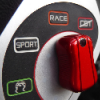Had a great day at Bedford yesterday. My mate who was circulating with me in his S1 Honda, said my car looked very unsettled and squirmy under heavy braking, such as into the first corner of the lap.
If your car seems squirmy under braking it sounds more like you are locking up the rears... What tyres are you using front and rear?
I'm wearing Toyo R888's FR and rear. The rears aren't locking I don't think but, I can see why you take that PoV!
Depending on what data you want to look at there's a school of thought which says after upgrading the front brakes, the rears are not worked as hard and the OTHER school of thought says in upgrading the fronts, you are adjusting the OEM balance and favouring more
front bias so, in order to restore the balance, you need to upgrade the rears.
Delving a little deeper, here's what I've gleaned:
In order to ensure vehicle stability under heavy braking, the rear brakes must not lock before the front brakes - correct? OK so...the lock-up point of the rear brakes is dependant on the
friction of the tyre combined with the
weight acting on the tyre ergo: the
less weight you have acting on the tyre, the less braking torque is required to induce the locking point.
When you upgrade the front brakes, you are effectively generating more torque for the same pressure, everything else being equal ie: the overall brake bias moves more towards the front.
There is a school of thought that says the locking point of the rear tyres is effectively lowered as the front is retarding more energy from the car, taking weight off the rear ergo, no need to upgrade the rears.
HOWEVER...there's a school of thought which says in order to re-address the balance, you need to upgrade the rears. This exerpt is taken from Stoptech's website:
....they end up actually increasing the FRONT bias. How? By increasing the effective caliper piston area and the rotor effective radius, these two factors work together to increase the 'mechanical gain' of the front brakes, building more torque for the same pressure, everything else being equal. So, from a bias perspective we are not pushing the vehicle toward instability, but rather just the opposite - we are underbraking the rear axle! The obvious impact would be an increase in stopping distance - probably the one thing the new owner was actually hoping to reduce. Ironic. So, say you chose to install these big brakes on the front axle but want to maintain the OEM bias. What's the answer? Well, one way would be to invest in big rear brakes too which increase the rear mechanical gain to the point that the system is balanced once again.
Stoptech then go full-circle and say there's actually no need to upgrade the rears at all!
Finally, under an OEM bias condition, the rear brakes only contribute about 15-20% of all the braking force the vehicle generates, and when you install sticky tires you actually DECREASE the amount of work they need to do. Why? Because at the higher deceleration levels afforded by race tires, there is more weight transfer taking place, reducing the normal force on the rear tires and increasing it on the front (remember F=µN from above?). If anything, we now want to decrease the rear effectiveness. Ironic once again.
Well, either way, I can firmly say I am completely confused

What I can't ignore though is the FACT that my VX (with AP 4 pots on the front) under heavy heavy braking, tends to weave a bit at the rear. How is this so?
Thinking this through; this *weaving* may be completely unrelated to the braking force at the rear.
I am wondering, given that I am thinking about increasing the spring rates on the car
< SEE HERE > that the relative (by that I mean on-track standards) softness of my spring rates is causing excessive
dive under heavy braking on track. This diving takes even more weight off the rear and really feels unsettling. I think it's time to look into this further





















